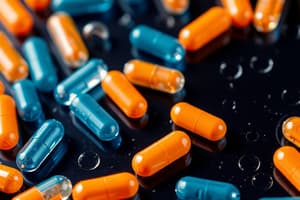Podcast
Questions and Answers
What is the mechanism of action of macrolides?
What is the mechanism of action of macrolides?
- Inhibit translation by binding 23S rRNA of the 50S subunit (correct)
- Disrupt cell wall synthesis
- Inhibit translation by binding 16S rRNA of the 30S subunit
- Inhibit DNA replication
Which condition is NOT a common adverse effect of lincosamides?
Which condition is NOT a common adverse effect of lincosamides?
- Rash
- Nausea
- C. difficile infection
- Acne (correct)
Which of the following is true regarding azithromycin compared to erythromycin and clarithromycin?
Which of the following is true regarding azithromycin compared to erythromycin and clarithromycin?
- It has almost no interaction potential. (correct)
- It is ineffective against pneumonia.
- It has a higher risk of drug interactions.
- It is a stronger inhibitor of the CYP 450 system.
What distinguishes tigecycline from other tetracyclines?
What distinguishes tigecycline from other tetracyclines?
What is a characteristic of the tetracycline class of antibiotics?
What is a characteristic of the tetracycline class of antibiotics?
What is the mechanism of action of linezolid?
What is the mechanism of action of linezolid?
Which of the following is a common adverse effect of linezolid?
Which of the following is a common adverse effect of linezolid?
What characterizes the action of nitroimidazoles like metronidazole?
What characterizes the action of nitroimidazoles like metronidazole?
Which fluoroquinolone is primarily renally excreted?
Which fluoroquinolone is primarily renally excreted?
What is a distinguishing feature of tedizolid compared to linezolid?
What is a distinguishing feature of tedizolid compared to linezolid?
Which microbial organisms are fluoroquinolones particularly ineffective against?
Which microbial organisms are fluoroquinolones particularly ineffective against?
Which fluoroquinolone is known to be effective against Pseudomonas aeruginosa?
Which fluoroquinolone is known to be effective against Pseudomonas aeruginosa?
Which drug class poses a risk of serotonin syndrome when combined with certain medications?
Which drug class poses a risk of serotonin syndrome when combined with certain medications?
Which class of antibiotics is specifically described as having activity against Pseudomonas aeruginosa?
Which class of antibiotics is specifically described as having activity against Pseudomonas aeruginosa?
Which adverse effect is associated with vancomycin administration?
Which adverse effect is associated with vancomycin administration?
What is the primary mechanism of action for daptomycin?
What is the primary mechanism of action for daptomycin?
Which of the following combinations is active against resistant bacteria, including Pseudomonas and Klebsiella pneumonia?
Which of the following combinations is active against resistant bacteria, including Pseudomonas and Klebsiella pneumonia?
Which cephalosporin generation is primarily eliminated renally and is effective against MSSA and Gram-negative rods?
Which cephalosporin generation is primarily eliminated renally and is effective against MSSA and Gram-negative rods?
Which antibiotic class is primarily used to treat MRSA infections?
Which antibiotic class is primarily used to treat MRSA infections?
What is a significant concern with rifamycins related to drug interactions?
What is a significant concern with rifamycins related to drug interactions?
Which type of penicillin is no longer available as a single agent but is found in combination therapy?
Which type of penicillin is no longer available as a single agent but is found in combination therapy?
Which antibiotic is known for attacking both Gram-positive and Gram-negative bacteria, but is not absorbed systemically?
Which antibiotic is known for attacking both Gram-positive and Gram-negative bacteria, but is not absorbed systemically?
Which beta-lactam antibiotic combination is NOT active against Pseudomonas?
Which beta-lactam antibiotic combination is NOT active against Pseudomonas?
Flashcards are hidden until you start studying
Study Notes
Penicillins
- Ureidopenicillin was a type of penicillin, but it is no longer available as a single agent.
- Ureidopenicillin could penetrate the cell wall of Pseudomonas, which aminopenicillin could not.
- Ureidopenicillin had additional adverse effects such as thrombocytopenia.
- All penicillins are susceptible to beta lactamases.
Penicillin Drug Development
- There are 5 main types of pencillins:
- Natural PCNs
- Anti-staph PCNs
- Aminopenicillins
- Antipseudomonal PCNs
- Penicillin/Beta-Lactamase Inhibitor Combinations
Penicillin/Beta-Lactamase Inhibitor Combinations
- There are 3 main types of penicillin/beta-lactamase inhibitor combinations:
- Piperacillin/Tazobactam (Zosyn®)
- Ampicillin/Sulbactam (Unasyn®)
- Amoxicillin/Clavulanate (Augmentin®)
- These combinations are used to treat Streptococci, MSSA, enterococci, and Gram negative rods.
- These combinations provide better coverage for Gram-negative rods than the parent drugs alone.
- They are active against anaerobes.
- Amp/sulbactam and amox/clav are not active against Pseudomonas.
- If a bacteria is susceptible to one beta lactam it is susceptible to all antistaphylococcal beta-lactams.
Cephalosporins
- There are 5 main types of cephalosporins:
- 1st generation cephalosporin
- 2nd generation cephalosporin
- 3rd generation cephalosporin
- 4th generation cephalosporin
- Anti-MRSA Cephalosporin
1st generation cephalosporin
- Examples of 1st generation cephalosporins:
- Cefalozin
- Cephalaxin
- Cefadroxil
- They are eliminated renally.
- They are useful against MSSA, streptococci and gram-negative rods.
2nd generation cephalosporin
- Examples of 2nd generation cephalosporins:
- Cefuroximine
- Cefoxitin (Anaerobic activity)
- Cefotaten (Anaerobic activity)
3rd generation cephalosporin activity
- Compared to the 1st and 2nd generation, they have decreased antistaph activity and better antistrep activity.
4th generation cephalosporin activity
- Examples of 4th generation cephalosporins are:
- Cefepime
- Cefimine
- Cefopodoimine
- They are eliminated renally.
Anti-MRSA Cephalosporin
- This type of cephalosporin is useful for treating MRSA and MSSA, strep, and Gram-negative rods.
- They are not useful for treating Pseudomonas.
- They are susceptible to beta lactamase.
Cephalosporin/beta-lactamase Inhibitor Combinations
- These combinations can kill highly resistant bacteria such as Pseudomonas aeruginosa, Klebsiella pneumonia.
Carbapenems
- Examples of carbapenems include:
- Imipenum/cilastin
- Meropenum
- Ertapenum
- They are renally eliminated.
- Imipenum has a higher seizure risk than other carbapenems.
Monobactam
- Aztreonam is the only monobactam drug.
- It is only active against gram-negative rods, including Pseudomonas.
- It is renally eliminated.
- Monobactams are not cross-reactive with other beta-lactam allergies, except ceftazidime and cefiderocol.
Carbapenem/Beta-lactamase Inhibitor Combinations
- Examples of Carbapenem/Beta-lactamase Inhibitor Combinations include:
- Meropenem-vaborbactam
- Imipenem- (cilastatin)-relebactam
- They have the same properties as meropenem and imipenem, but with additional activity.
Glycopeptides
- Vancomycin is the main glycopeptide drug.
- It inhibits cell wall synthesis by binding to the terminal of D-ala-D-ala chain of peptidoglycan.
- It has poor bioavailability.
- It is widely distributed and eliminates renally.
- It is active against Gram-positive aerobes and anaerobes, including MRSA.
- It is used for MRSA infections because it does not kill beta-lactam susceptible staphylococci as quickly as beta-lactams.
- Beta lactams kill MSSA better than glycopolypeptides.
- Adverse effects include Vancomycin infusion syndrome, red man syndrome, nephrotoxicity, and ototoxicity.
Lipoglycopeptide(s)
- Examples of lipoglycopeptides include:
- Telavancin (skin/skin and pneumonia from gram-positive structure)
- Oritavancin (skin/skin infection)
- Dalbavancin (skin infections and C. difficile)
Fosfomycin
- It inhibits monomer production.
- It is bactericidal.
- It is renally eliminated.
- It has moderate bioavailability.
- It is active against Pseudomonas, staph, and enterococci.
Cyclic Lipopeptide
- Daptomycin is a cyclic lipopeptide.
- It inserts into the cell membrane of Gram-positive organisms leading to cation leak, depolarization, and cell death.
- It is bactericidal.
- It has poor absorption and is inactive in the lung.
- It is excreted renally.
- It is active against Gram-positive aerobes and anaerobes, including MRSA and VRE.
Rifamycins
- Rifamycins block transcription.
- They are bactericidal.
- Rifamycins include: Rifampin, Rifabutin, Rifapentine, Rifaximin.
- They are active against Gram-positive and Gram-negative bacteria as well as mycobacteria.
- They are strong inducers of CYP450, and enzyme system that metabolizes many drugs.
- Adverse effects include rash, hypersensitivity, and hepatotoxicity.
- Rifamycins discolor secretions orange-red.
- Rifapentine has an extended t½.
- Rifaximin is not absorbed.
Protein Synthesis Inhibitors
- Most are bacteriostatic.
- They are effective against most bacteria.
Aminoglycosides
- Examples of aminoglycosides include:
- Gentamicin
- Tobramycin
- Amikacin
- Neomycin
- Streptomycin
- Plazomicin
- They inhibit translation by binding to 16S rRNA of the 30S ribosomal subunit causing misreading, leading to cell death.
- They are bactericidal.
- They have low bioavailability.
- They eliminate renally.
- They have short half-lives.
- They have excellent activity vs. gram-negative bacteria.
Macrolides
- Examples of macrolides include:
- Erythromycin
- Clarithromycin
- Azithromycin
- They inhibit translation by binding to the 23s rRNA of the 50S subunit of the ribosome..
- They are bacteriostatic.
- They achieve high intracellular concentrations.
- They are highly bioavailable.
- Macrolide adverse effects include GI disturbances (N/V/D) and rash.
- They have drug interactions with Erythromycin, Clarithromycin (inhibitors of CYP 450 system).
- Azithromycin has almost no interaction potential.
- They are used for pneumonia and URTIs.
Lincosamides
- Examples of Lincosamides include:
- Clindamycin
- They inhibit translation by binding to the 50S subunit of bacterial ribosomes.
- They are bacteriostatic.
- They are active against staphylococci (including some MRSA) and streptococci, anaerobes (but not C.difficile).
- Adverse effects include C.difficile infection, diarrhoea, abdominal pain, nausea, and rash.
- They are mainly used for SSTIs, anaerobic infections, and acne.
Tetracycline
- Examples of Tetracyclines include:
- Minocycline, doxycycline
- They inhibit translation by binding reversibly to 16S rRNA of the 30S ribosomal subunit, blocking tRNA.
- They are bacteriostatic.
- They are active against Staphylococci including many MRSA and some strep.
Other Tetracyclines
- Examples of modified tetracyclines include:
- Tigecycline, Eravacycline, Omadacycline
- They have an expanded spectrum.
- They have poor absorption.
- They have very high distribution and low plasma concentrations.
- They have a long half-life,
- They are most hepatic elimination.
- They cover many GNR and GPC including VRE and MRSA.
- They have good anaerobic coverage.
- They do NOT cover Staphylococcus or Proteus.
- Tigecycline has significant adverse effects.
Nitroimidazoles
- Examples of Nitroimidazoles include:
- Metronidazole, Tinidazole
- They interact with DNA leading to loss in DNA structure and strand breakage.
- They are bactericidal.
Oxalidinones
- Examples of Oxalidinones include:
- Linezolid, Tedizolid
- They bind to the 23S rRNA of the 50S subunit, preventing protein synthesis by blocking the formation of the 70S initiation complex..
- They are bacteriostatic.
- They are highly bioavailable.
- Oxalidinones elimination is:
- Linezolid- Dual hepatic metabolism (not via CYP450) and renal elimination
- Tedizolid- Hepatic elimination
- Linezolid is a weak, reversible inhibitor of monoamine oxidase, so be somewhat cautious of antidepressants when taking linezolid.
- They are effective against Gram-positive aerobes, including staphylococci, streptococci, including MRSA, and enterococci, including VRE.
- Adverse effects include possibility of serotonin syndrome with some drugs, and bone marrow suppression.
Fluoroquinolones
- Examples of Fluoroquinolones include:
- Ofloxacin, Ciprofloxacin, Levofloxacin, Moxifloxacin,
- They bind to DNA gyrase (topo II) or topoisomerase IV, leading to DNA breaks.
- They are bactericidal.
- They are highly bioavailable.
- "Respiratory FQs” (aka Antipneumococcal FQs) have good activity vs.S.pneumoniae and include:
- Levofloxacin, moxifloxacin, gemifloxacin, delafloxacin, gatifloxacin
- Ciprofloxacin, ofloxacin, and earlier FQs are not antipneumococcal.
- Ciprofloxacin used in pneumonia caused by GNR.
- Fluoroquinolones are largely renally excreted, except moxifloxacin (hepatic) and gemifloxacin (dual).
- Activity varies between drugs.
- All are active vs Enterobacterales, atypical organisms.
- Ciprofloxacin, levofloxacin, and delafloxacin are active vs.P.aeruginosa.
- Ciprofloxacin has poor Gram-positive activity.
- There are treatment failures with streptococci and staphylococci.
- Resistance is common in P.aeruginosa and S.aureus, uncommon in streptococci, and very high in E.coli in some parts of the world and country.
- Adverse effects include:
- Lower seizure threshold
- N/V/D
- Photosensitivity
- Arthropathy
- QTc prolongation
- Elderly: Mental status changes
- Absorption is reduced drastically with concomitant multivalent cations.
Studying That Suits You
Use AI to generate personalized quizzes and flashcards to suit your learning preferences.



